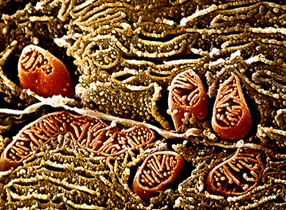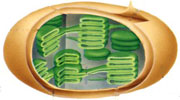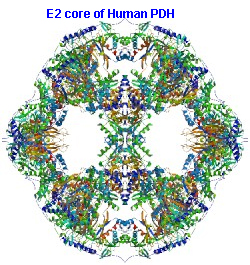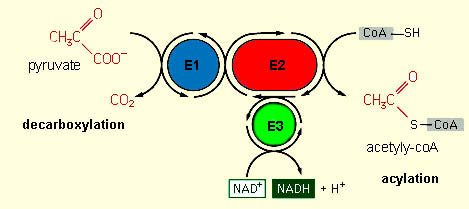.......
3 Main Molecular-Cellular
Mechanisms of ADP
Phosphorylation |
1.
Substrate Level
Phosphorylation - transfer of "P" to ADP or
GDP. |
|

|
see
ecb5e
steps
7 & 10
of glycolysis
see page
435 13.2*
or ecb panel 13.1 |
2.
Chemiosomosis -
or Oxidative Phosphorylation of
ADP via
e- capture to make to ATP.
Oxidation of glucose produces reduced
NADHs that pass e-'s
generating a H+ gradient.
oxidation subst-H
(glu)
+ NAD+ox
--H:-->
NADHred
+ product (CO2 +
H2O)
NADH ---e-transport--->
H+ proton motive
force --ATP synthase-->
ATP
overview of
mitochondrial processes* |
3.
Photosynthetic
Phosphorylation - sunlight
provides e-
energy to add P to ADP.
Light
+ H2O + NADP+ ---->
NADPH --e--->
H+
--ATP synthase-->
ATP |
 overview of chloroplast
processes*
overview of chloroplast
processes* |
| |
1st -
CELLULAR RESPIRATION (Heterotrophy) is
the Oxidation of Food
Molecules.
6
reaction processes involved in cellular
respiration:
(glucose oxidation)
|
a combination of anaerobic and aerobic metabolic
pathways...
|
| |
Glycolysis
[cytosol]
glucose --> 2 pyruvate +
NADH + ATP |
|
Pyruvate
decarboxylation
[mitochondria mitoplasm]
pyruvate -->
Acetyl-coenzymeA via pyruvate
dehydrogenase complex |
|
Fatty Acid
Oxidation
[mitochondrial
mitopalsm]
oxidation of beta carbon of fatty acid
yields NADH/FADH2
& A-coA |
| |
Krebs Cycle
[mitochondria
mitoplasm]
Acetyl-coenzyme-A --> CO2
+ H2O + NADH + GTP + FADH2 |
| |
Electron
Transport Chain (ETC)
[mitochondrial membranes]
passage of e's from NADH/FADH2 to O2
--> H2O +
H+ gradient |
| |
ATP synthase
[mitochondrial membrane]
mitochondrial membrane protein of 24 protein subunits, which
makes ATP as H+ move into
mitoplasm with
their chemical gradient.
Mechanical rotation of the ATP synthase
creates chemical bond energy.
|
 |
Overview via Locations
of these Processes*
|
GLYCO-LYSIS: Greek
(glykos) = "sweet"
+ "splitting"
 * a
text description * a
text description
Embden-Meyerhof-Parnas
Pathway of eukaryotes (1920s)
-
10 step
enzymatic pathway that converts
hexose (C6)
--> 2 PYRUVATE (C3)
+ 4 ATP (2 net) + 2
NADH |
|
- anaerobic - no direct
requirement of oxygen, but can occur
in oxygen's presence
- cytoplasmic location (► seems too structured for
randomness of aqueous solutions
maybe a membrane-less organelle system?)
Glycolytic
Pathway*
|
|
A - energy investment phase...
(coupled Rx's)
ecb4e
Panel 13.1 steps 1-3*
phosphorylation of low energy
intermediates to high energy ones
|
|
B
- energy capture phase...
2 key reactions types:
A
- redox reaction
(glyceraldehyde3-P-dehydrogenase)
B
- two
substrate level
phosphorylations
ecb5e
Panel 13.1 steps 6 & 7*
substrate-P +
ADP --->
substrate + ATP
|
 Karp
fig 5.6 (pathway)
&
ecb
panel 13.1 pg 428 Karp
fig 5.6 (pathway)
&
ecb
panel 13.1 pg 428 |
HOW CELLS USE PRODUCTS of
GLYCOLYSIS Ancillary
Pathways
Fates of PYRUVATE...
if anaerobic – "fermentations"...
1. alcoholic
fermentation - via alcohol dehydrogenase (ecb 13.6a ethanol)*
Red
wine bacterium's Proteome mapped
2.
lactic acid respiration - via lactic acid dehydrogenase
(ecb
13.6b muscle)*
if
aerobic -
3.
Krebs Cycle -
pyruvate enters mitochondrial
Krebs Citiric Acid Cycle
Fates of NADH... =
SHUTTLES*
 *
text
description *
text
description
it is
used in cytosol for reductive reactions, but some
cells can move it to mitochondria.
mitochondrial inner membrane
is impervious to NAD+/NADH, but some cell
have
an evolutionary advantage with Shuttles moving
e's from the cytoplasmic NADH's
into
mitochondrial NADH or FADH2
for eventual use in the ETC...
glycerol-P shuttle
-
skeletal muscle/brain
malate shuttle - liver, kidney,
heart muscle

Review of the KEY
REACTIONS of GLYCOLYSIS
redox reaction involving NAD+
(see
step 6*)
substrate level
phosphorylation (see steps 7 & 10)
energy summary of
GLYCOLYSIS
(see ecb 13.4*)
2 ATP to initiate pathway
2 substrate level
phosphorylations
makes
4 ATPs (2 net ATPs), 2
NADH, and 2 PYRUVATE
anaerobic (oxygen not directly required)
Fermentations
(lactate & alcohol) & the Shuttles
glycolysis summary
animation (7 min)please view@home

KREBS
CYCLE... is primary process for Aerobic
Respiration
[also
referred to as: Citric Acid
Cycle or Tricarboxylic Acid Cycle]
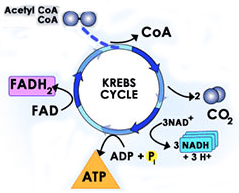
A cyclical biochemical pathway resulting in Oxidation of cellular fuel molecules, such as:
Carbs (glucose), Fatty Acids, & Amino
Acids, while making CO2, NADH,
FADH2, &
ATP.
Some HISTORY
1910's
- enzymatic nature described - Dehydrogenases... (EC 1.
= Oxidoreductases)
1930's - substrates identified
as - di-COOH's and tri-COOH's
experiments on
minced flight muscle prep's via respirometry*
1937 - Sir Hans Krebs [pic*] -
citrate synthase (EC 2.3.3.1 - known as
condensing enzyme)
acetyl-CoA
[2C]
+ OAA [4C]
---> citrate [6C]
+ CoA-SH
1948
- cycle localized within the
mitochondria*
1961 - Peter Mitchell - proposes Chemiosmosis... [a proton (H+)
gradient makes ATP]
► but prior to Krebs
Cycle we need to get glycolytic pyruvate into
mitochondria... figure*

Pyruvate
decarboxylation via a Multienzyme Complex
Pyruvate Dehyrogenase
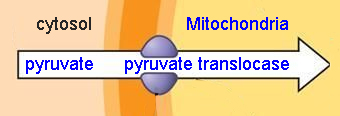
Pyruvate
dehydrogenase is complex of 3 enzymes (60
proteins in toto) that
catalyzes the
Oxidative Decarboxylation
of the alpha-keto acid
pyruvate
Pyruvate dehydrogenase [EC
1.2.4.1] is a multienzyme
complex of 3 enzymes:
60 proteins subunits [8,000 kD and a diameter of
~45nm - larger than ribosome]
that
is found in the mitoplasm of eukaryotes and many
prokaryotes.
E1. pyruvate
decarboxylase
[EC
4.1.1.1.]
12 dimers =
24 identical subunits
E2. lipoamide transacetylase (reductase) [EC
2.3.1.12]
8
trimers = 24 identical subunits, each 3
lipoates
E3. dihydrolipoyl dehydrogenase
[EC 1.8.1.4]
6
dimers 12 subunits with FAD
 (figure)* (figure)*
*
Overview of Aerobic
Respiration:
Processes include:
Glycolysis, Pyruvate Oxidation, Krebs Cycle,
and the ETC.
Overall reaction
of the Kreb's Cycle:
acetyl-CoA + 3NAD + E-FAD + GDP + P + 2H2O
---->
--->
CoASH
+ 3NADH
+ E-FADH2 +
GTP
+ 2CO2
Acetyl-S-CoA from pyruvate oxidation
enters the Krebs Cycle:
8 ENZYMATIC REACTIONS of KREBS
CYCLE
simple*
& complex: panel 13.2 &
4 dehydrogenases - ISDH, a KGDH, SDH, MDH,
EC 1.
oxidoreductase
2
hydratases -
aconitatse & fumarase
(forms C=C)
EC 4. lyase
1
thiokinase -
succinyl-CoA synthatase
EC 6. ligase
1
synthetase -
citrate synthase
EC 2. transferase
2
multi-enzyme complexes - each with 60 proteins
& 5 coenzymes each
1. pyruvate
dehydrogenase
(figure)
EC
1. oxidoreductase
2. alpha
ketoglutarate dehydrogenase (figure*)
EC
1. oxidoreductase

| |
the Cycle itself -
|
Important
Key Metabolic Reactions of KREBS
CYCLE
review
of key
reactions
NAD & FAD are
reduced
(3 NADH & 1 FADH /ACoA)
substrate
level phosphorylation occurs
GDP +
P -->
2 GTP/glu
(≈
2 ATP eq.)
decarboxylation
(-COOH
- 2 from
AcoA & 1 from PDH
step = 3 total)
acylation via CoASH (succinyl-CoA - akin to PDH;
thus 2 times)
|
thus Each turn
of the Cycle
(C6 --> 2 C3, cycle occurs 2x)
4 protons
passed to coe's
(3
NADH
& 1 FADH2)
= 6 NADH & 2 FADH2
2
CO2's are
released
=
4 CO2's
1
GDP is
phosphorylated to GTP
(equivalent to ATP) = 2
ATP equivalents
|
full version of Krebs - panel 13.2
pg442
|
|
Cellular
Respiration Summary - animation*8 min -
view@home |
 |
Carbohydrates vs. Fats as
aerobic energy sources for cell respiration?
the
energy sources for cellular respiration
include
fats & carbs - fig 13.10* ]
FATTY
ACID METABOLISM
► 1st is
breakdown of a fat:
triacylglycerol =
ebc fig 13.11 Fats*
fat/lipid droplet
& fatty acid = figure & ecb panel 2.5 pg 74
► converts free
fatty acids in blood into to Acetyl-CoA in
the mitochondria
The steps of Fatty Acid
Oxidation Cycle are referred to as BETA OXIDATION
A. oxidation of
COOH end of free fatty acid &
linking FFA to CoASH in cytoplasm
H3C-H2C-H2C-H2C-H2C-COOH + CoA-SH
B. transport of
fatty acyl-coA into mitoplasm from cytoplasm
H3C-H2C-H2C-H2C-H2C-CO-S-CoA
C. oxidation of fatty acyl-coA into 2 carbon fragments of
Acetyl-CoA --> K.C.
H3C-H2C-H2C-H2C-COOH
+ H3C-CO-S-CoA
 B
B
there
are 4 enzymatic reactions of the beta-oxidation cycle...
1.
long fatty acyl-CoA
SYNTHASE [EC 2.3.1.86 - transferase]
FA-COOH +
ATP +
CoASH
<--> FAcoA + AMP +
PP
converts cytoplasmic FFA to fatty-acyl-coA
[c-(cn)-c-c-ScoA]
2.
carnitine
acyl-TRANSFERASE 1 [EC
2.3.1.21]
(outer
mito memb.)
FAcoA +
carnitine
<-> Fatty
acyl-carnitine +
CoASH
transfers
FAcoA onto carnitine for transport across mito...
carnitine is a
quaternary ammonium compound.
3.
carnitine
acyl-TRANSFERASE 2
(on mitoplasm side memb.)
Fatty acyl-carnitine
+
CoASH <--> FAcoA + carnitine
releases
carnitine & leaves FAcoA
inside the mitoplasm
FATTY
ACYL TRANSPORT*- steps 1 to 3
4.
fatty
acyl-coA DEHYDROGENASE
[EC 1.3.8.7]
(in
mitoplasm)
oxidizes mitochondrial FAcoA
& reduces FAD and
NAD+

step 4
- of Beta-Oxidation Cycle via
fatty acyl-coA dehydrogenase enzyme [EC 1.3.8.7]
the sequence of steps for this
mitochondrial dehydrogenase enzyme system
include...
a) dehydrogenation
with - FAD --> FADH2
b) hydration
- addition of water
c) dehydrogenation
with - NAD --> NADH.
d)
thiol clevage
with
- CoASH
fig 13.11A pg 439* & Fatty
acids & amino acids lead to A-Co-A's*
release of a 2carbon fragment as Acetyl-CoA,
feeds to Krebs cycle
Net
result: each turn of the cycle shortens
a
long chain fatty acid by 2 carbons
generating 1 AcoA for
entry into Krebs cycle +
1 NADH
& 1 FADH2 ...
so far little direct ATP
(or equivalent GTP)
has been made per Glucose
(4 in glycolysis & 2 in KC)
Heterotrophic energy sources for
making ATP for Cell Respiration includes:
Carbs, Fats, &
Proteins *
and amino acids*
Most of the energy of glucose oxidation in now in
NADH, FADH2 & only 4 ATP net
made by substrate level phosphorylation. The
majority of cellular ATP will everntually
be
made in the Electron
Transfer System of the mitochondria...
Back to Bb
and
 Lecture
topic (...the ETC) Lecture
topic (...the ETC)
SKIP this table
|
Balance Sheet Aerobic Oxidation
6C- glucose
vs. 6C- FFA |
|
► Rule of
Thumb... the P/O ratio
(via mito & ETC) 1 NADH = 3 ATP & 1 FADH2
= 2 ATP
|
| Cell RESPIRATION via glucose |
beta-OXIDATION via 6C-FFA (c-c-c-c-c-c) |
| to start - GLYCOLYSIS |
- 2 ATP |
@
LIGASE step |
- 1 ATP |
glyceraldehyde DH
PGA kinase (via SLP)
pyruvate kinase (via SLP) |
+ 2 NADH* + 6
ATP
+ 2 ATP
+ 2 ATP |
glycerol-1P of fat |
→ 1 NADH = +2 ATP
→ 1 DHAP = +2 ATP
|
| KREBS Cycle per each PYR |
per 2 cycles @
Fatty-AcoA-dehydrogenase |
|
PDH
-
2CO2 |
+ 2
NADH + 6
ATP |
+ 3 AcoA*
+ 2 FADH2
+ 2 NADH |
+
4 ATP
+
6 ATP
+ 10 ATP |
ISDH
-
2CO2
αKGDH
- 2CO2
thiokinase
SDH
MDH |
+ 2
NADH + 6
ATP
+ 2 NADH
+ 6 ATP
+ 2
GTP
+ 2 ATP
+ 2 FADH2
+ 4 ATP
+ 2
NADH + 6
ATP |
Totals 1 glucose
--> 2 ATP + 2 pyruvate --->
- 6
CO2 + 2 ATP + 10 NADH* + 2
FADH2 + 2 GTP |
Totals
6C-FFA via
beta-oxidation
--> 10 ATP
& *Krebs cycle (3 AcoA) -->
~ 36 ATP |
*per gly+Krebs+shuttles total ATP
= 36 to 38
 ATP via 1 AcoA alone
= 12
ATP via 1 AcoA alone
= 12 |
total ATP = ~ 46 ATP - 1
ATP = ~ 45 ATP
a gain of ~
7 to 9 ATP |
Skip the material below for fall 2011
- go to ETC lectures
Regulation of
Glucose Oxidation
(via Glycolysis & Krebs
Cycle)...
substrate availability - mass
action controls flow of intermediates [out & in] -
fig
13.23*
allosteric
inhibition - PFK-1
& 2*
(recall
classical
feedback inhibition models - fig 4.38 pg 152)
covalent modification - reversible
phosphorylation...
protein kinases & phosphoprotein phosphatases [Review]
| ► 4 key
enzymes are involved in Krebs regulation… |
|
1. PDH
[arsenic
poisoning] |
+
AMP/NAD -
SER-P by
kinase > inactive |
|
2. citrate
synthetase |
+ ADP - ATP/NADH/cit/AcoA |
|
3. isocitrate
dehydrogenase |
+ ADP/Ca+2 -
ATP |
|
4.
alpha-keto gluatarate dehydrogenase |
+ Ca+2 - AcoA
& NADH |
 my
figure*
[apply regulation to the metabolic
charts &
Nicholson ]
my
figure*
[apply regulation to the metabolic
charts &
Nicholson ]
Karp's
5e version fig 5.7 page 185
Cancer &
Metabolic Reprogramming
1st: Cellular Respiration (HETEROTROPHY)... Oxidation of Food
Molecules
Evolution of anaerobic/aerobic
metabolism was a major step
in the history of life on planet
Earth...
|
described as:
- series cytoplasmic & mitochondrial...
- linked enzymatic
pathways
-
catalyzing stepwise OXIDATION of 'food ' molecules to
make ATP & NADH
physiological
view:
uptake of O2 & release
of CO2
biochemical
view:
O2 reduction
& CO2
production
|
3
Stages:
1. Digestion of food polymers [CH2O]n --> [CH2O] monomers
(we'll
skip)
2. Production of
AcoA (via
pyruvate)
--> glycolysis &/or Fatty Acid oxidation
3. Oxidation
of AcoA to CO2 &
H2O -->
Krebs Cycle & Electron Transfer
|

|
|

